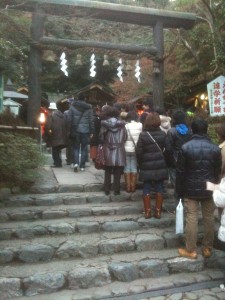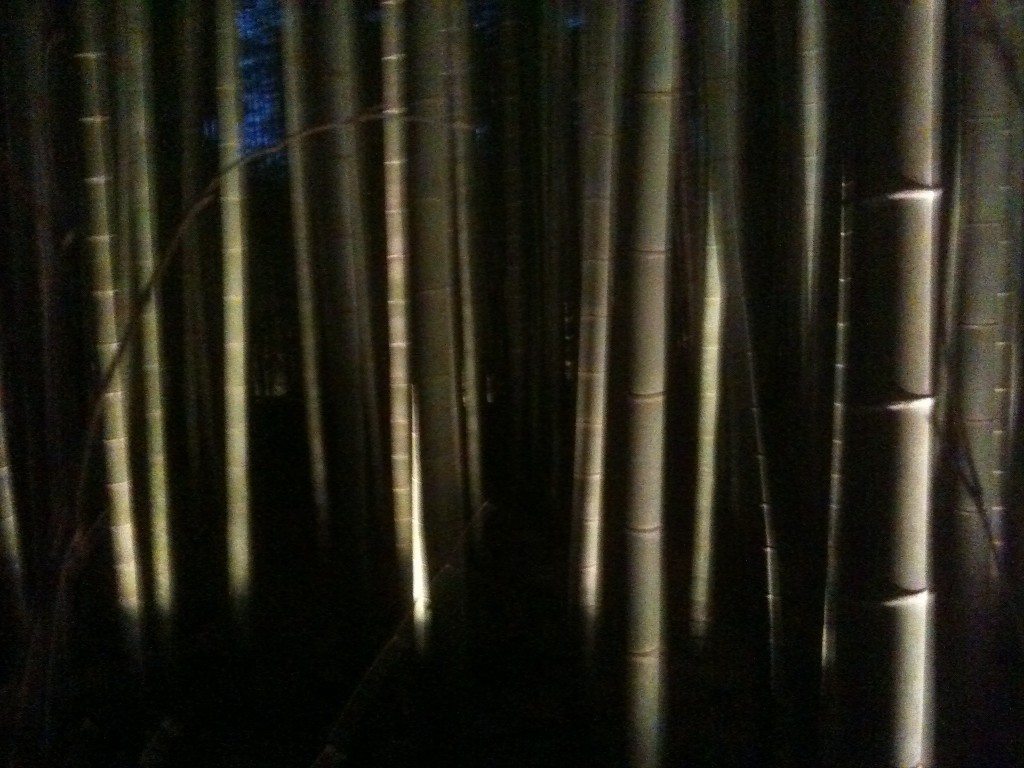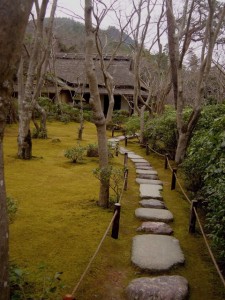
Queueing up at dusk at Nonomiya Shrine
Those of us who live in Kyoto are spoilt. As soon as the glorious autumn colour light-ups finish, we get the Hanatouro light-up in Arashiyama. The area was once a pleasure-ground for the Heian aristocracy, when boats plied languidly across the river carrying performers of dance and music for nobles who drank saké, composed poems and dangled their long sleeves in the cooling water.
Last night I took a stroll around the area at dusk, to admire the expensive light effects. It happened to coincide with the full moon lunar eclipse, when the best efforts of mankind were dwarfed by the celestial lightshow on high as the moon was turned golden by the eerie shadowing and unshadowing. You can’t compete with magic like that!
Nonetheless Nonomiya and its approaches had a magic of their own, standing out in clear relief against the looming darkness. The small shrine dates back to the seventh century and is noted for its ancient style of torii, with bare logs covered in bark. In the grounds you can find a moss garden and a shrine to a deity of easy delivery (Shirafuku Inari).
Lovers of the Heian era, like myself, have a special place in their hearts for the shrine, for Lady Rokujo came here with her daughter in the tenth chapter of The Tale of Genji. The daughter had been appointed as the Ise virgin (Saigu), and the custom was for the young princess to stay for a year at the shrine to purify herself. It was here, at this sacred spot, that Genji came to take his leave of Lady Rokujo whose jealousy had caused the death of his wife. It’s an illicit meeting in a place of purification, and highly charged.
Genji offers Rokujo a sprig of sakaki, pushing it through the fencing in provocative manner. ‘With heart unchanging as this evergreen,/This sacred tree, I enter the sacred gate,’ he says. In this way Murasaki Shikibu skilfully turns Shinto’s holy symbol into a tool of seduction.

Bamboo light-up around Nonomiya: even an iphone was alive to its beauty
The chief association of Nonomiya, however, is with sadness and parting, for the young princesses who came here for purification had to take leave of their family when departing for Ise, never to meet again. (The system was abolished in the fourteenth century.) The custom was for the father to give her a comb, a symbolic token of farewell, then an imperial procession would accompany her on the five-day journey. A festival every year recreates the scene, leading from the shrine down to the famous Togetsukyo Bridge where the princess would have crossed over to her new life.

Okochi Sanso in daylight: imagine the magic by night
For the Hanatouro event, the path to Nonomiya through a bamboo grove is beautifully illuminated, and from the shrine one can make one’s way up to Okochi Sanso (the villa of the actor Okochi Denjiro) where for the price of Y700 you can enter the most exquisite fairyland.
The Hanatouro light-up continues till Dec 18, from 5.00 to 8.30 each day. Highly recommended for anyone in the Kyoto area, though try to make it a week day as the weekends get very crowded. There’s five km of walkway with open air lanterns, student performances, spectacular flower arrangements, five temples, the Rakushisha hut where Basho stayed, and bamboo bliss with Nonomiya too. Prayers for success in exams or a good love connection are particularly favoured. Head for the shrine this week, and you too may feel illuminated!

A.J. comments in his inimitable manner…
GreenLights
ShintoNights
WordSongBright
MoonPlayDelight
Wild Eyes AlwayZ
On Lover Street
The Rock People
PomeMindHeart
KokoroJob
high5 backlog